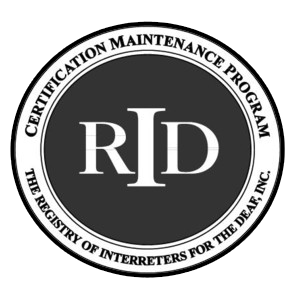Educational Settings
INTERPRETING IN EDUCATIONAL SETTINGS (K-12)
Following the passage of a number of laws concerning the education of deaf children, educational interpreting has become more common in elementary and secondary schools. This is a growing profession and can be one way of making school programs and services more accessible to children who are deaf. As a member of the educational team, the interpreter should be an educated and qualified professional.
What is the role of the educational interpreter?
The fundamental role of an interpreter, regardless of specialty or place of employment, is to facilitate communication between persons who are deaf and hard of hearing and others.
Educational interpreters facilitate communication between deaf students and others, including teachers, service providers, and peers within the educational environment. Many educational environments have a communication policy which should be clearly defined to the interpreter applicant. The educational team may be composed of school personnel and parents and may be more structured in some school districts than others. The educational interpreter is a memberof the educational team and should be afforded every opportunity to attend meetings where educational guidelines are discussed concerning students who are provided services by that interpreter.
What responsibilities are appropriate for an educational interpreter?
Interpreting is the primary responsibility of the interpreter. The interpreter may perform this responsibility in a variety of settings, in and outside of the classroom including:
- instructional activities
- field trips
- club meetings
- assemblies
- counseling sessions
- athletic competitions
Interpreting is the educational interpreter's primary role, and must take priority over any other demands. In some schools, interpreters may also interpret for deaf parents, deaf teachers, and other deaf employees.
Interpreters may have additional responsibilities when not interpreting.1 In determining appropriate responsibilities, it is important to utilize specialized competencies and skills of the interpreter and assign only those responsibilities for which the interpreter is qualified.
Responsibilities that maximize the interpreter's effectiveness during non-interpreting periods of time might include:
- planning and preparing for the interpreting task
- presenting in-service training about educational interpreting
- working with teachers to develop ways of increasing interaction between deaf students and their peers
- if qualified, tutoring the student who is deaf or hard of hearing
- if qualified, teaching sign language to other school staff and to pupils who are not deaf
Responsibilities that tend to reduce the interpreter's effectiveness may include:
- copying and filing
- playground supervision
- bus attendant duty
- lunchroom duty
- monitoring study hall
The educational interpreter's responsibilities and the relative proportion of time between interpreting and non-interpreting responsibilities are likely to vary from one work setting to another and may be influenced by a number of factors which may include:
- number of students who are deaf or hard of hearing in the school or district and distribution across grade levels and school buildings
- possibility of physical injury due to stress or overuse.2
- nature of the employment; full-time, part-time, or hourly
- interpreter's background, knowledge, skill, and competencies
- qualifications and availability of the interpreting staff
How can confusion about the interpreter's responsibilities be avoided?
The role and responsibility of the interpreter is distinct from that of the teacher and that of other professionals in the educational setting. This distinction must be kept clear. For example, for the interpreter to provide classroom instruction anddiscipline directly to a student would be inappropriate because that is the teacher's responsibility.
A clear and detailed job description, prepared in advance of hiring and shared with the interpreter applicant and with others who need to understand the interpreter's duties, will help avoid confusion and misunderstanding.
Who should supervise the educational interpreter?
A member of the educational administration staff who has an understanding of interpreting should supervise the interpreter.
In most cases, hiring an agency outside the educational institution or using a teacher in whose class the educational interpreter works would not be appropriate. The interpreter's supervisor may have interpreting skills, which is valuable, but the supervisor should at least know what interpreting is, how the interpreter functions best as a member of the educational team, and when interpreting is or is not the most appropriate service. If the supervisor is not qualified to evaluate interpreting skills or performance, an outside consultant knowledgeable in interpreter assessment and skill development should be hired.
What qualifications should the educational interpreter have?
Interpreting is a highly specialized professional field; simply knowing sign language does not qualify a person as an interpreter.
Professional sign language interpreters develop their specialization through extensive training and practice over a long period of time. In addition, skills in oral transliteration may be needed. Throughout their careers, interpretersimprove their skills, knowledge, and professionalism through continued training and through participation in RID. The use of a comprehensive written professional development plan will guide the educational interpreter to meet professional goals, including that of certification.
In interpreting, as in other professions, appropriate credentials are an important indicator of competence. RID awards certification to interpreters who successfully pass national tests. The tests assess not only language knowledge and communication skills, but also knowledge and judgment on issues of ethics, culture and professionalism which form the essential foundation for quality interpreting. The assessments do not test for additional specialist skills necessary in educational settings.
Many interpreters working in educational settings either already have or are working toward certification. An increasing number of states are requiring educational interpreters to have interpreting credentials.
Educational interpreting is a specialty requiring additional knowledge and skills. In the classroom, the instructional content varies significantly, and the skills and knowledge necessary to qualify an interpreter vary accordingly. In the primarygrades, the interpreter needs a broad basic knowledge of the subject areas such as mathematics, social studies, and language arts, and should have an understanding of child development. At the secondary level, the interpreter needs sufficient knowledge and understanding of the content areas to be able to interpret highly technical concepts and terminology accurately and meaningfully.
How is reasonable compensation determined for the educational interpreter?
Pay levels and employee benefits for educational interpreters should be competitive with that of other professional school employees. They should be based on interpreting skills, education, experience, certification, performance, and job responsibilities.
Creation of positions with appropriate pay and benefits is a key to attracting and keeping qualified professional interpreters.
RID Standard Practice Paper on Educational Interpreting.



